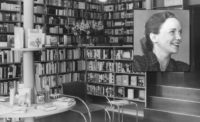RECORD speaks with leading practitioners about the impact of the Bauhaus on their lives and work.
Claire Weisz
Principal in Charge, WXY Architecture and Urban Design, NYC
In my first year of architecture school at the University of Toronto in the 1980s, I discovered Paul Klee’s Pedagogical Sketchbook, based on his design-theory course at the Bauhaus. I remember one chapter about line and structure; Klee’s point was that structure was something you could draw, not just calculate. The book taught me how to think about composition and function together—it erased the somewhat artificial line between the way artists and architects think.
But most early works on the Bauhaus omitted the women, so we didn’t grasp the full range of ideas, and need to consider the Bauhaus and its influence anew.
Juergen Riehm
Founding Principal, 1100 Architect, NYC
I was educated in Trier, which is filled with Roman ruins and thought to be Germany’s oldest city—not a lot of modern architecture there. The Bauhaus was taught mainly as part of architectural history. After graduating, I traveled to Berlin and visited the Bauhaus Archive. (Dessau and Weimar, then in East Germany, were not accessible to me.) Seeing it all together made a powerful impression. One of the lessons, which has stayed with me, is the importance of creating architecture that will endure over time, rather than a fashion statement.
Meijin Yoon
Dean, College of Architecture, Art and Planning, Cornell University
Principal, Höweler + Yoon, Boston
To me, the Bauhaus represents the understanding that architecture is an applied art that intersects with industry, technology, society, politics, even communications and media. It’s significant that so many Bauhaus members were accomplished in more than one field.
Herbert Bayer’s Diagram of the Field of Vision, advocating a multidisciplinary approach to solving problems, couldn’t be more timely. The Bauhaus was dealing with relatively straightforward new materials and methods of industrial production. But today, technology has exploded, and we should be looking to intersections between design and fields like biology and computation. We need to take the Bauhaus’s original tree-ring diagram, showing its expansive approach, and add a few more rings to make it even more relevant now.
Helmut Jahn
Director/CEO, Jahn, Chicago
I was taught by people from the Bauhaus or their successors—although, interestingly enough, when I was in architecture school in Munich, in the early ’60s, everyone was looking to the American skyscrapers of Mies and SOM. But, except for Mies, the Bauhaus people who came to the U.S. never did anything better than they’d done at the Bauhaus.
Robert A.M. Stern
Founder and Senior Partner, Robert A.M. Stern Architects, NYC
Former Dean, Yale School of Architecture
I’m anti-Bauhaus, in that I didn’t jettison historical styles. In fact, I had to figure them out for myself as a reaction against the nihilism of the Bauhaus and its heirs at Yale.
The Bauhaus was a wild, completely undisciplined environment. When I was in architecture school, in the early 1960s, we would sit around late at night, mulling over the sex lives of the Bauhausians. Sybil Moholy-Nagy, then a frequent visitor to Yale, took fabulous swipes at the Bauhaus and the pretensions of the “Bauhauslers,” who came to America and rewrote the story for delicate ears in Cambridge.
My teachers at Yale, all former students of Gropius at Harvard, had to go through death-throes of agony to overcome the Bauhaus. Among them were Philip Johnson and Paul Rudolph, who was in many ways Gropius’s best student. They were interested in the Bauhaus, but they never accepted its principles.
Whole careers were built on having been or studied with someone who’d been there. There were genuine talents at the Bauhaus, but the architecture that came out of it wasn’t really very interesting. It was a better place for crafts.
As for me, I had to fundamentally reject much of what I was taught as gospel in the early 1960s. The Bauhaus caused me a lot of architectural soul-searching.
Will Bruder
Principal, Will Bruder Architects, Phoenix
In 1965, I was accepted at IIT, where I was going to study with Mies. But over the summer, I got a job in Wisconsin with William Wenzler, a pioneer in thin-shell concrete. I loved his work, so I decided to stay and enroll at the University of Wisconsin-Milwaukee instead of IIT. My first-year design instructor was Fred Berman, and it was as if I was at the Bauhaus. We learned color theory, proportion, scale through Bauhaus-style exercises—fundamentals that gave everyone equal footing. Those two semesters changed my life.
Tom Kundig
Principal/Owner, Olson Kundig, Seattle
I grew up under the influence of the Bauhaus. My parents were Swiss; my father, Moritz Kundig, was an architect who’d studied at the ETH, in Zurich. In Spokane, where we lived, he was part of a group of very good architects, a number of whom had trained with Gropius at Harvard and carried his ideas back with them. In the postwar years, there was a moment, in many midsized towns, when there was a lot of uniformly good Modernist work. I grew up around it. What I learned over the years, directly from the Bauhaus, is that the beauty of the building is in the craft, the tectonics—the making of the thing.
Deborah Berke
Dean, Yale School of Architecture
Partner, Deborah Berke Partners, NYC
At RISD, where I studied as an undergraduate, everyone comes together under one roof, whether you’re going to be an illustrator, a glassblower, a painter, a furniture maker, or an architect. RISD is not a direct descendent of the Bauhaus, but there’s a parallel in the nonhierarchical intermingling of design and making at all scales. Common to both the Bauhaus, during the brief period when it functioned as the Bauhaus, and RISD is that people with all those different talents study together. I consider a range in ways of thinking and making key to being a good architect.
Craig Hodgetts
Design Partner, Mithun | Hodgetts + Fung, Culver City, California
Before I went to architecture school, I studied engineering, theater, and art. So I was very attracted to the Bauhaus’s cross-disciplinary nature. In 1969, I helped start the design school at CalArts, which I thought of as a modern incarnation of the Bauhaus. I remember doing architecture exercises with the theater and dance departments. That lasted about four years, until the administration changed.
A few years later, Ming Fung and I created a short-lived design consortium called Harmonica, which included architects, filmmakers, graphic designers—again, like the Bauhaus. During that time, I resisted being called an architect, because I didn’t want to be pigeonholed.
We still seek cross-disciplinary work, but the opportunities today are fewer because the market is so segmented. The Bauhaus had lots of very, very eccentric people, breaking the box in all kinds of ways. I would have had a blast there.





Post a comment to this article
Report Abusive Comment